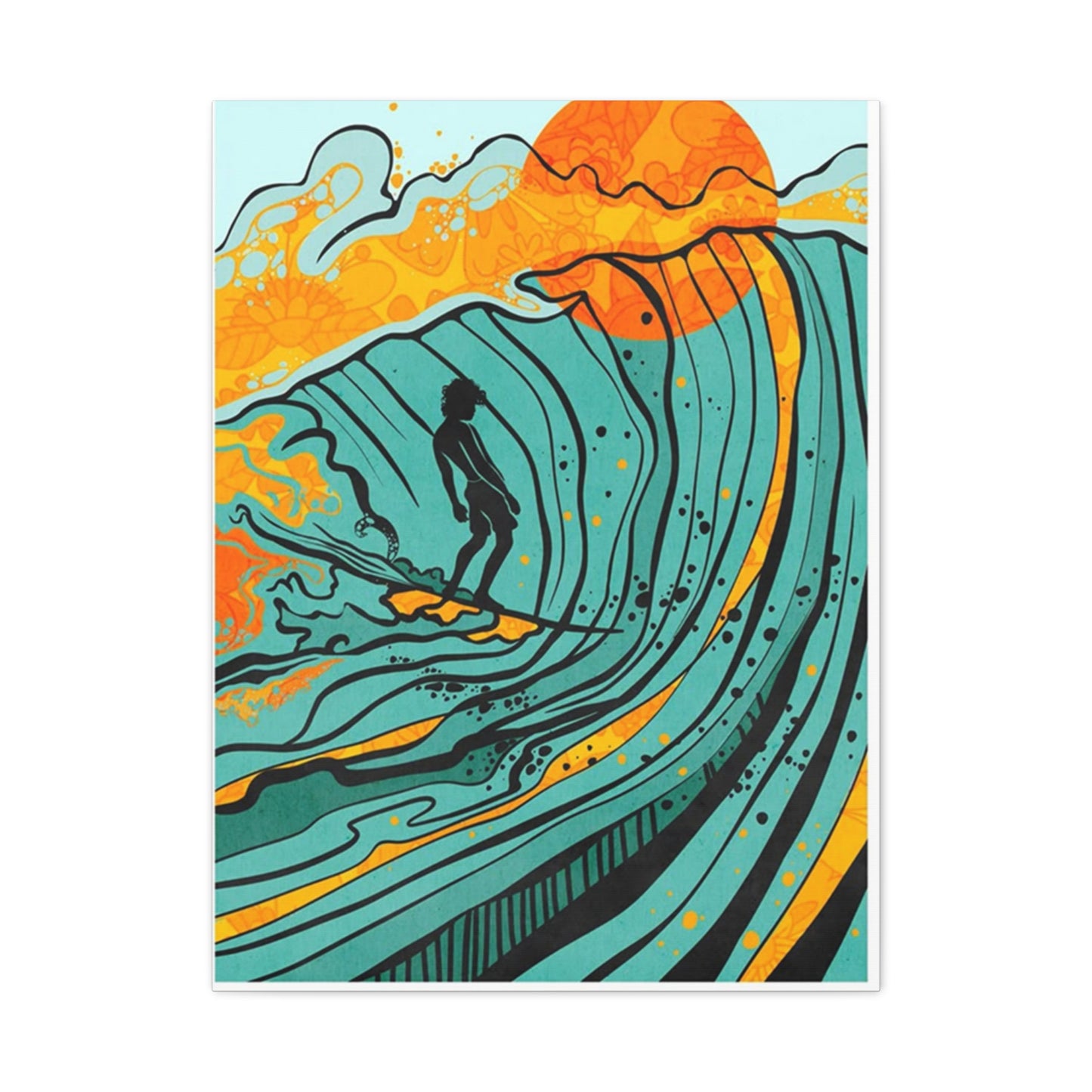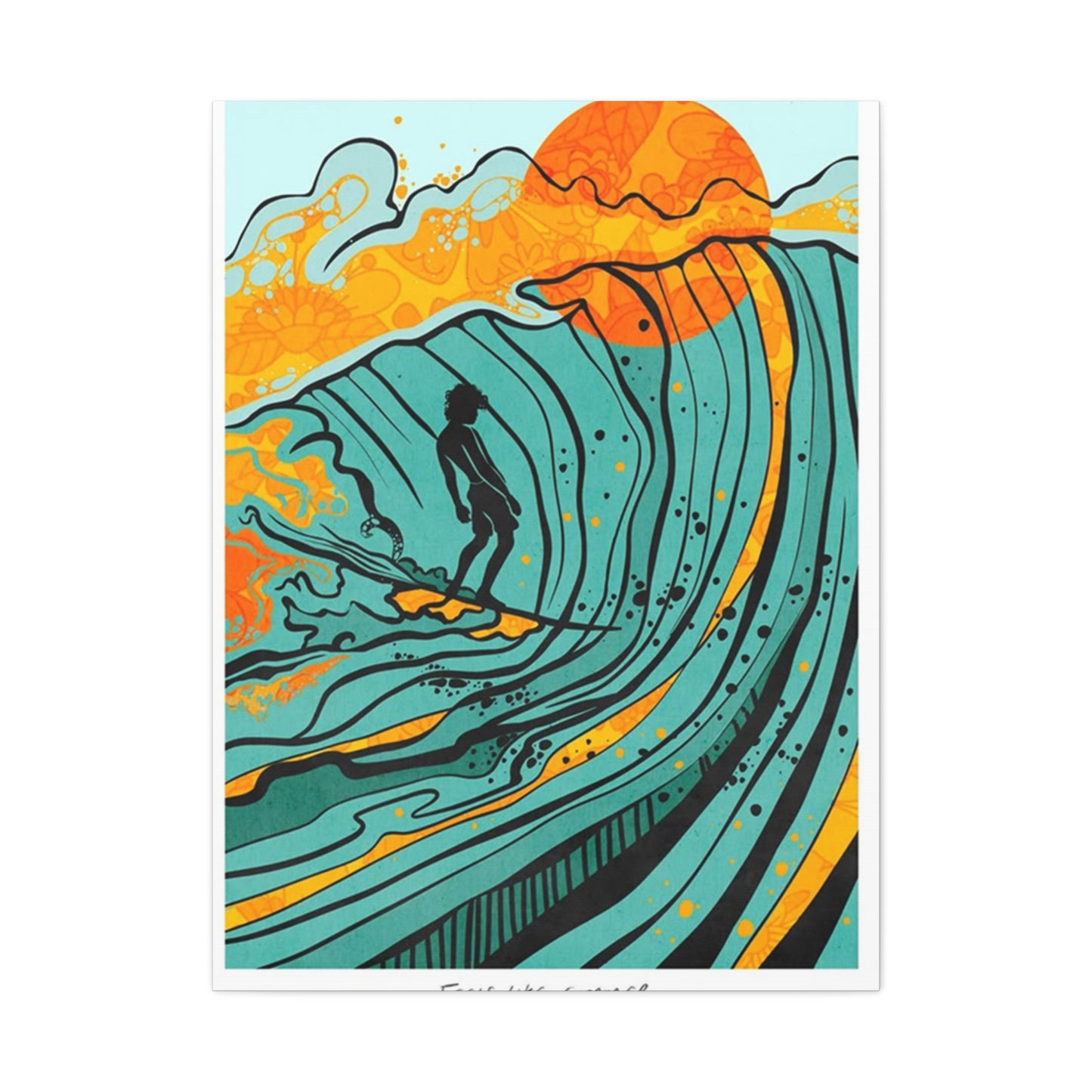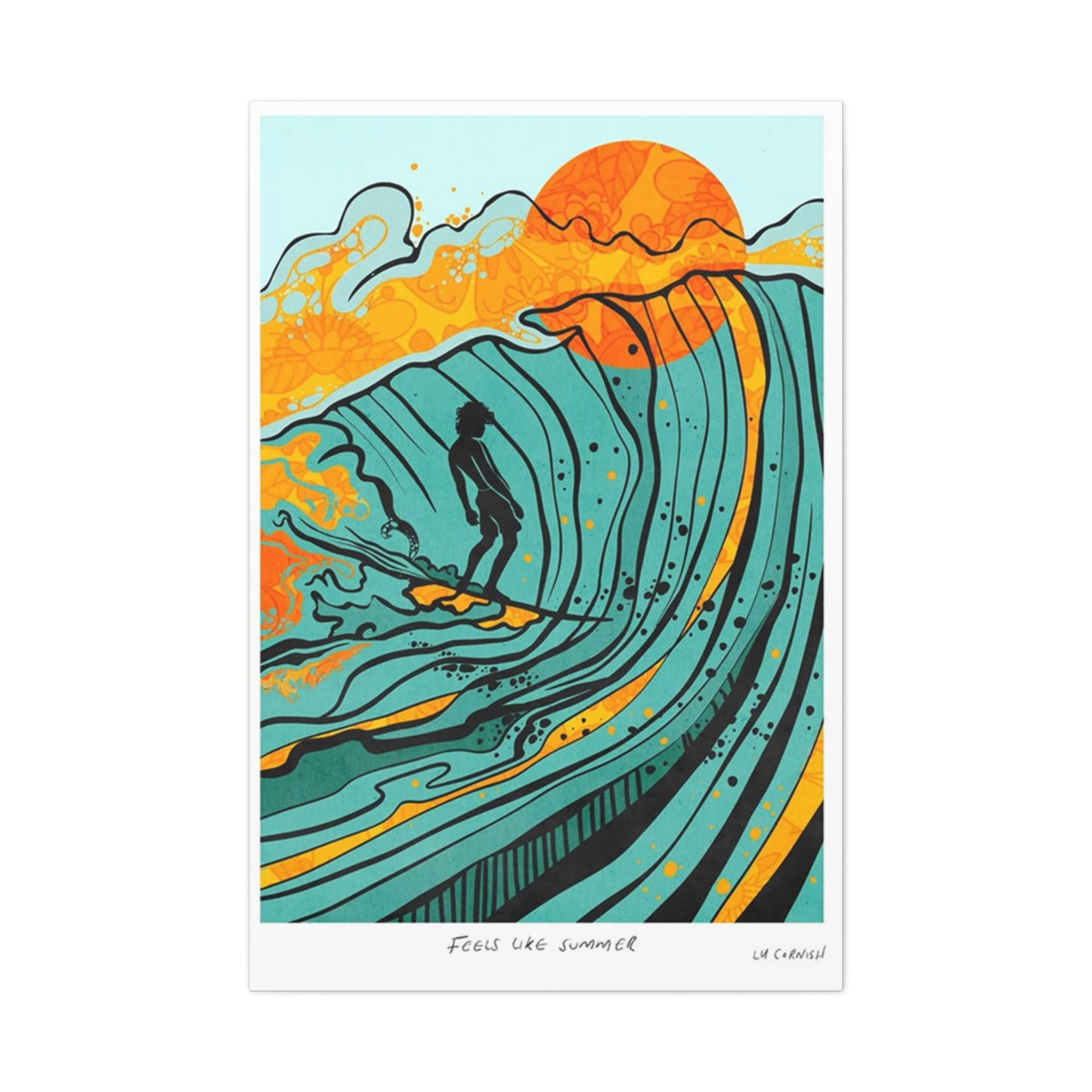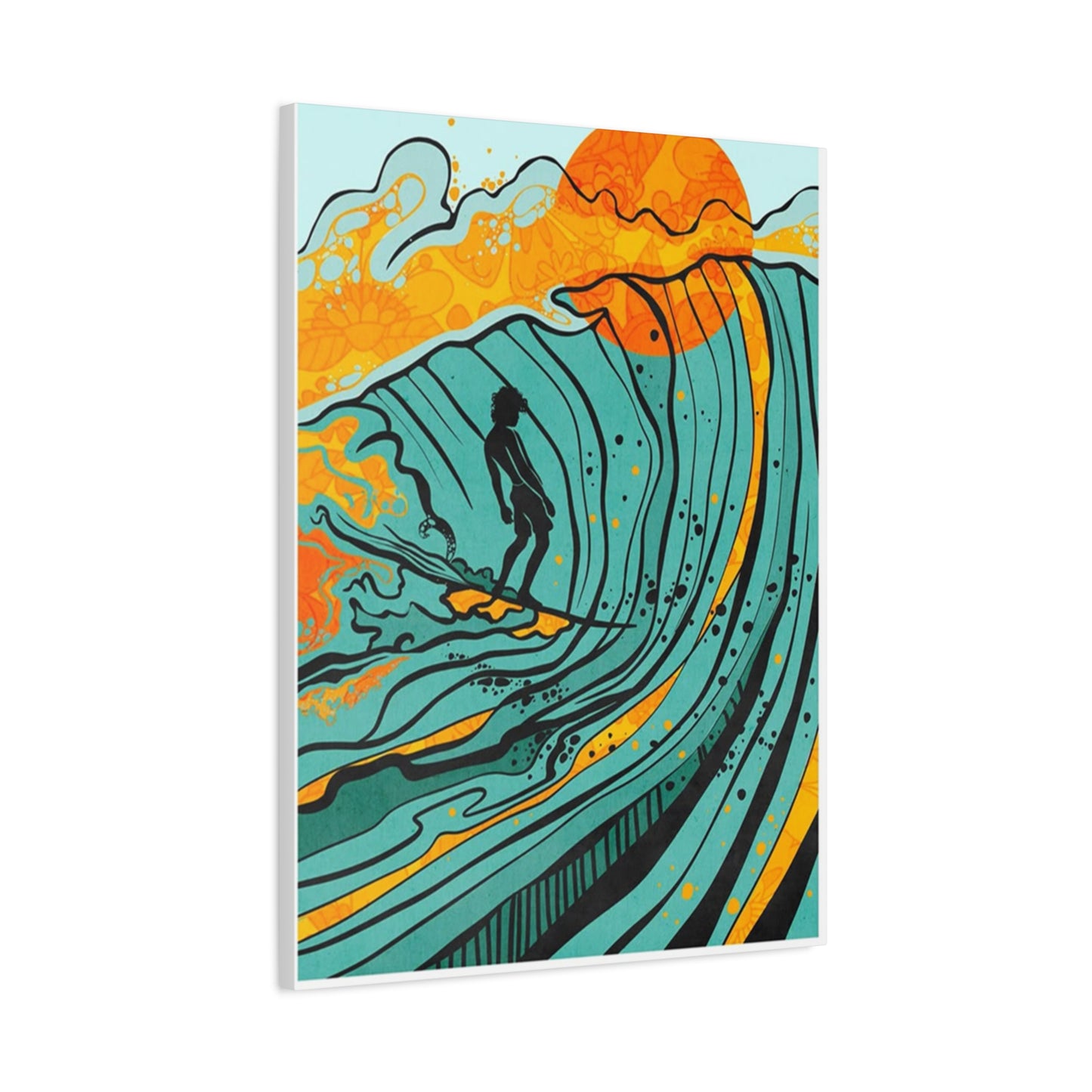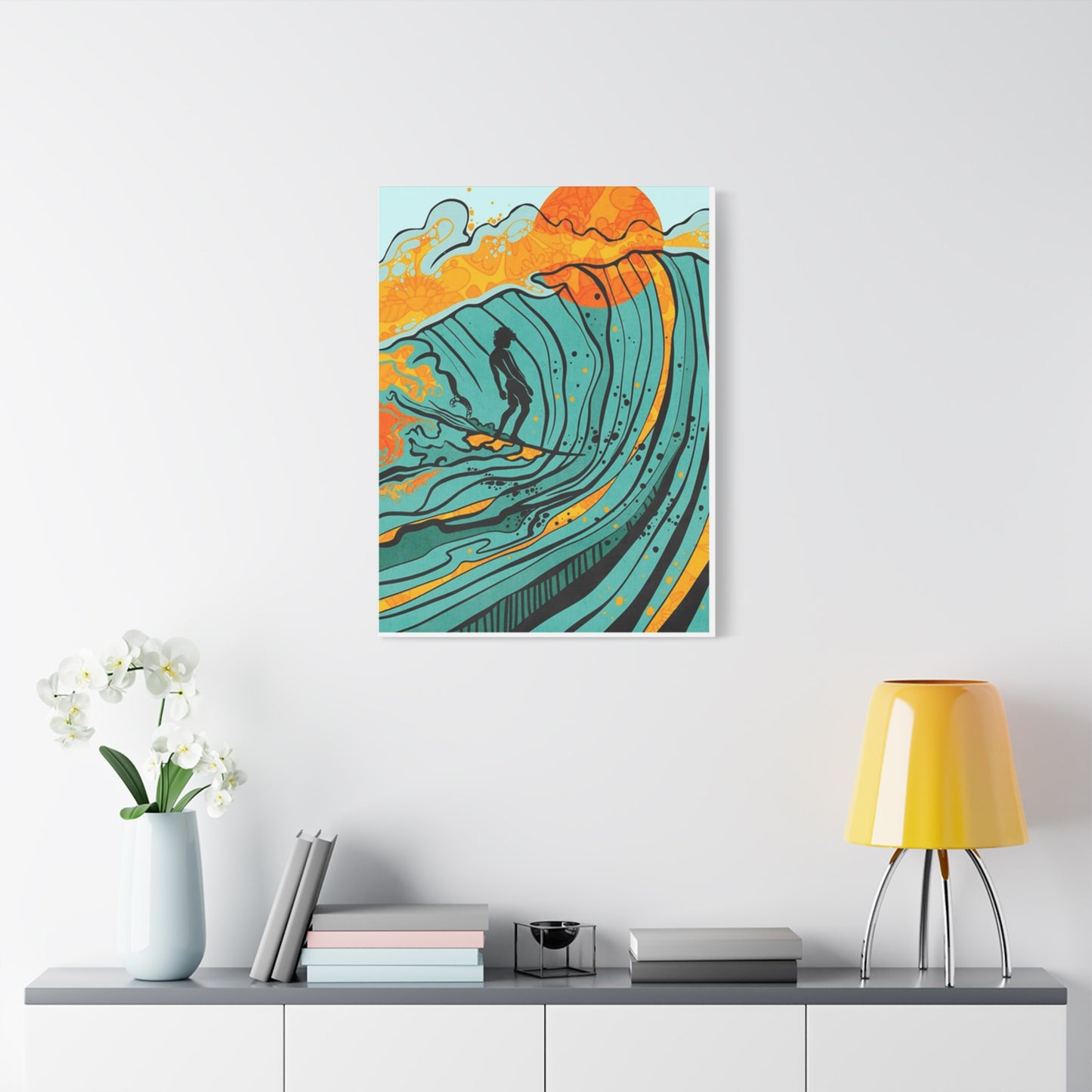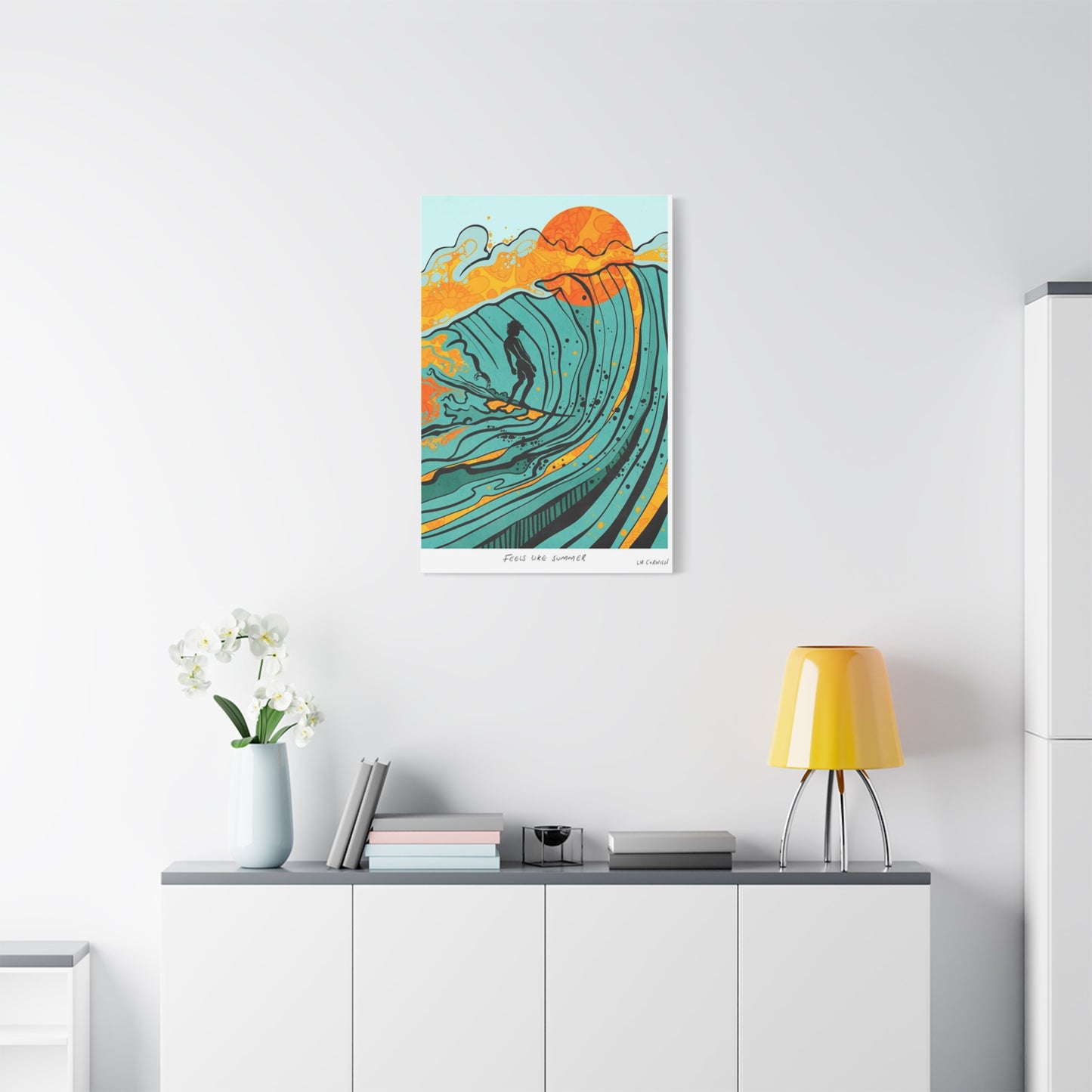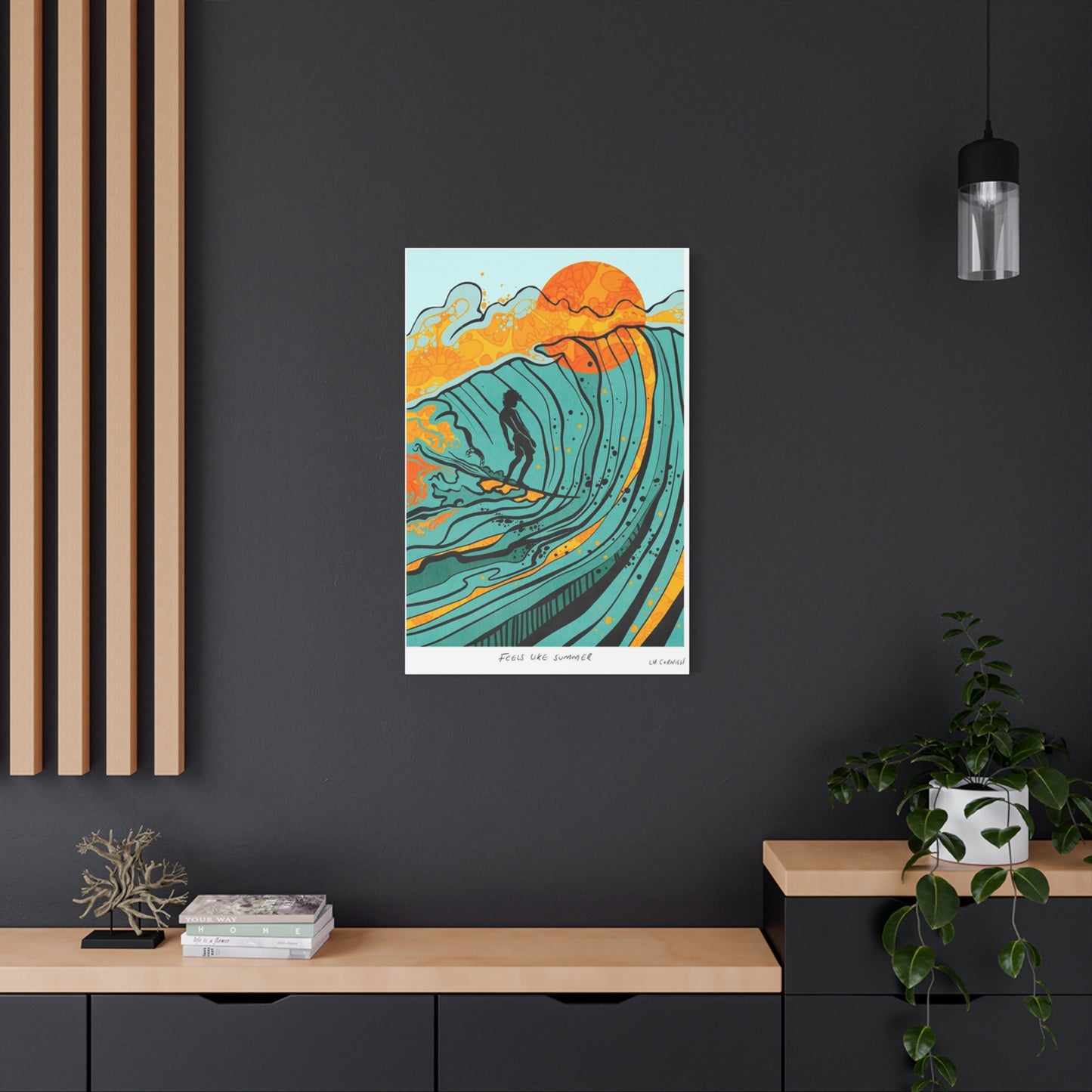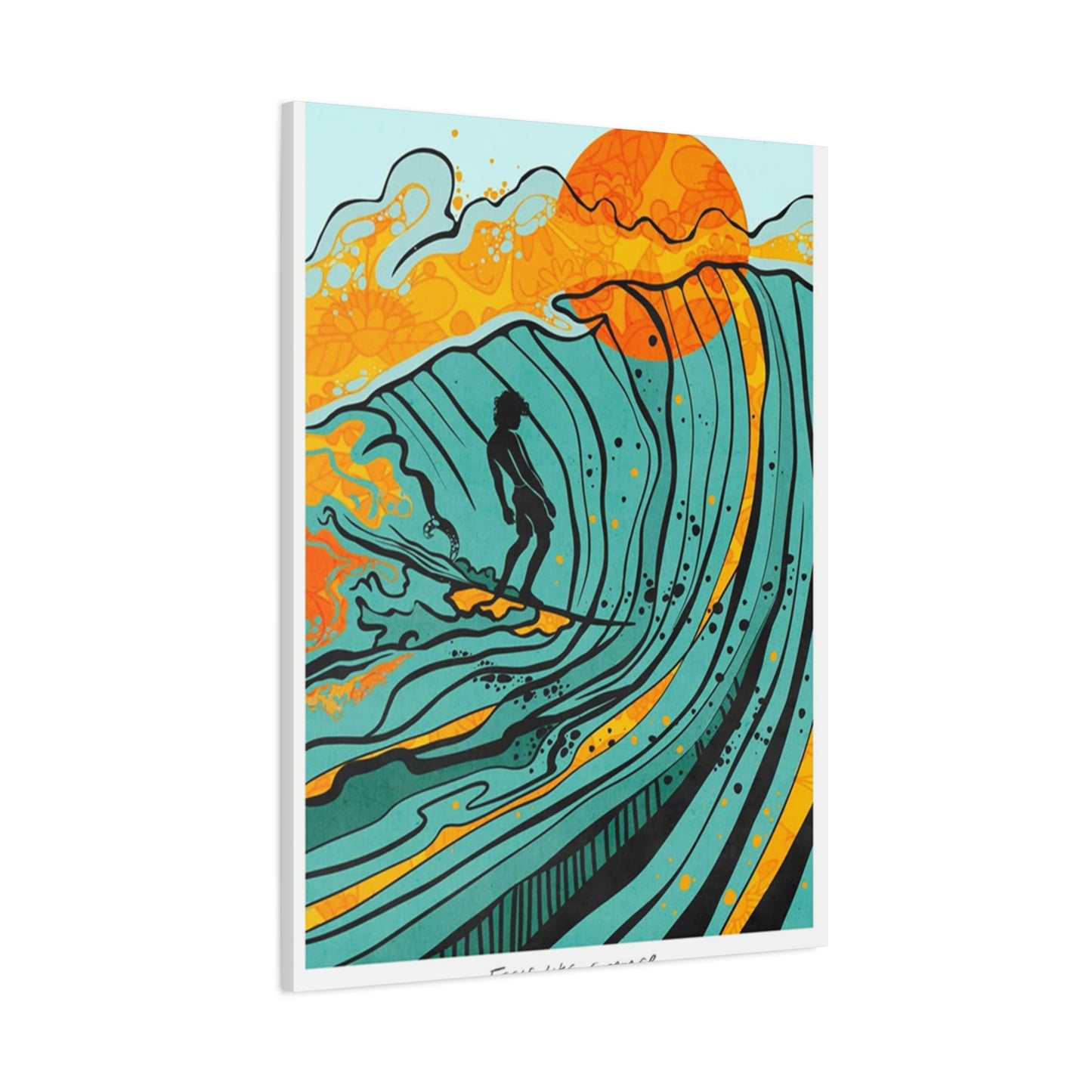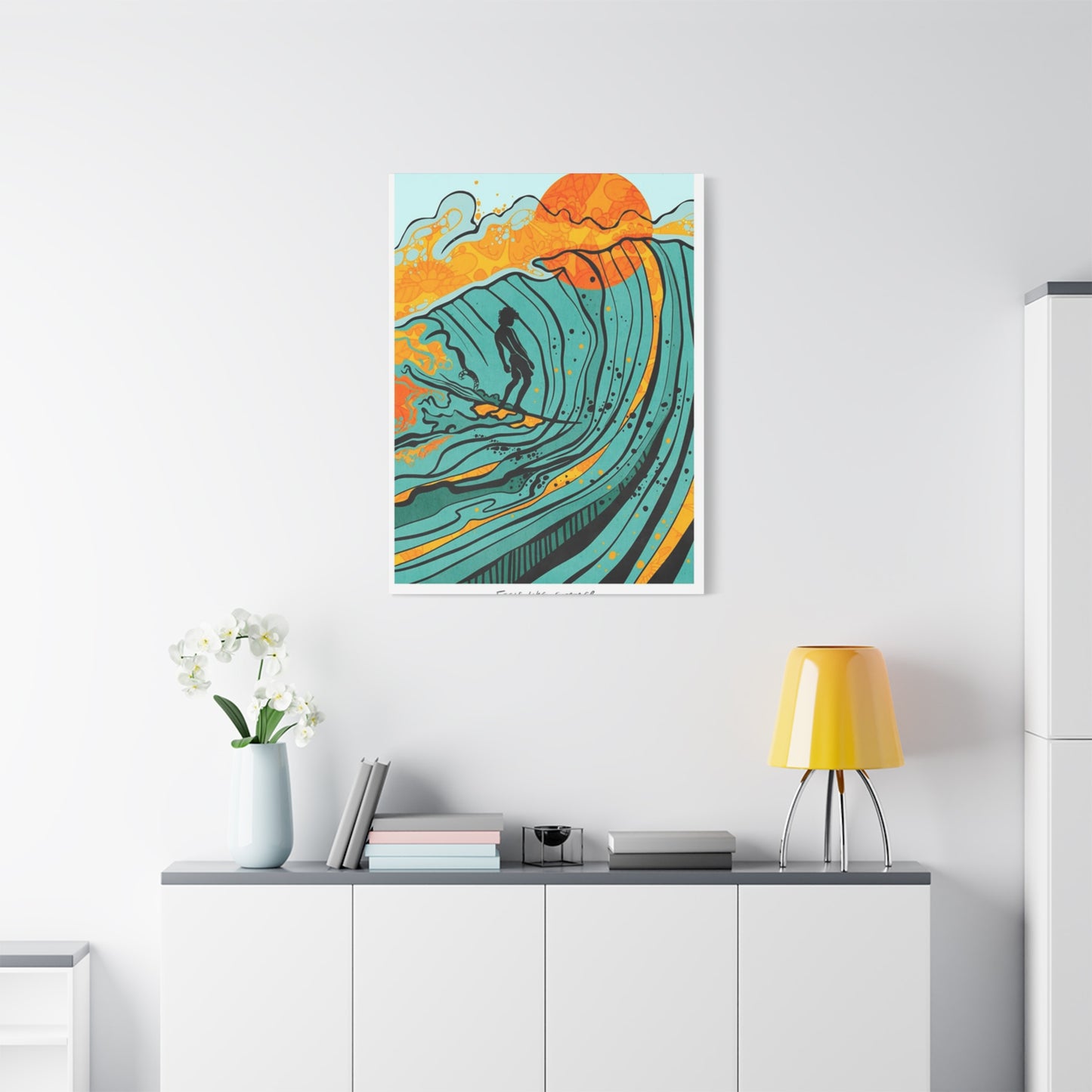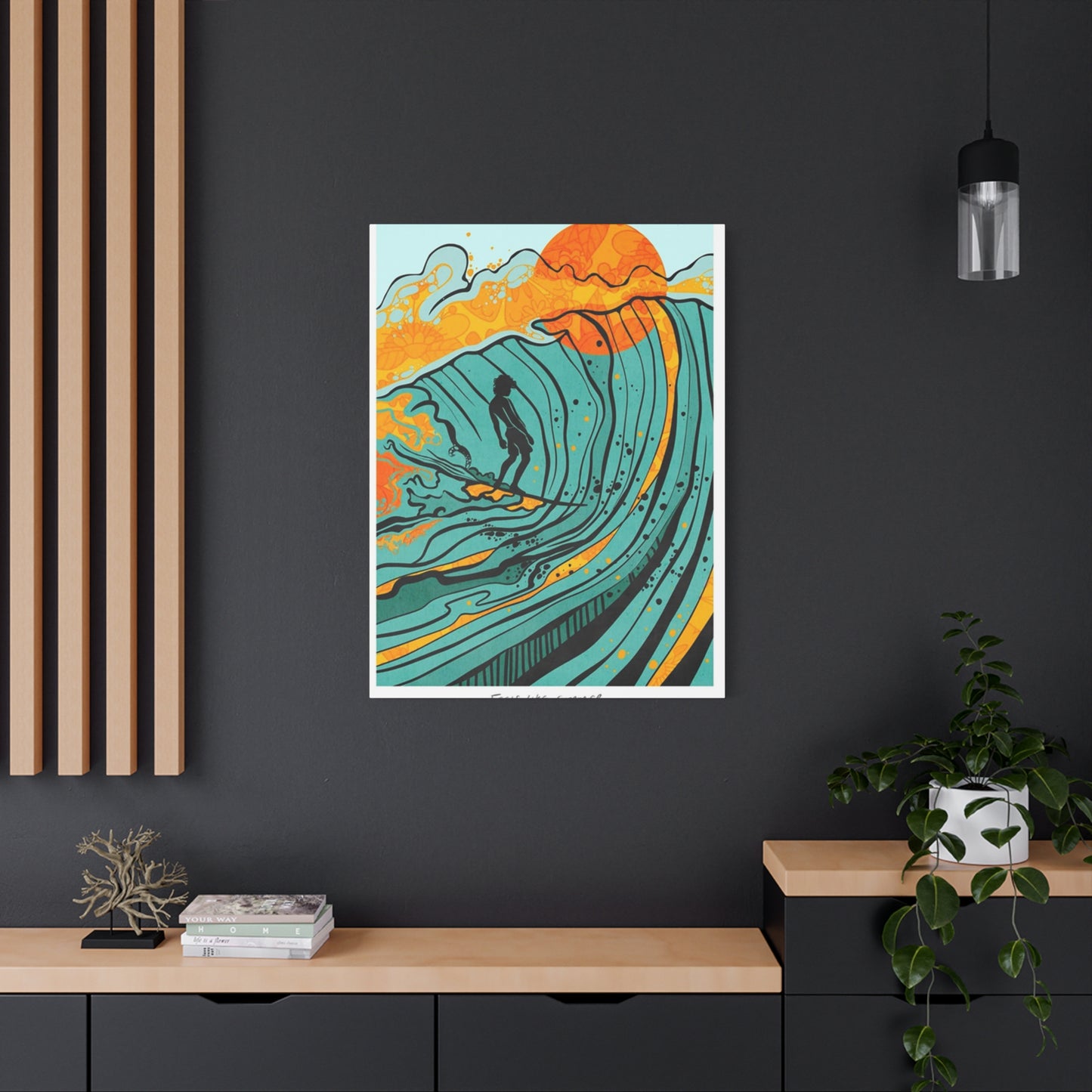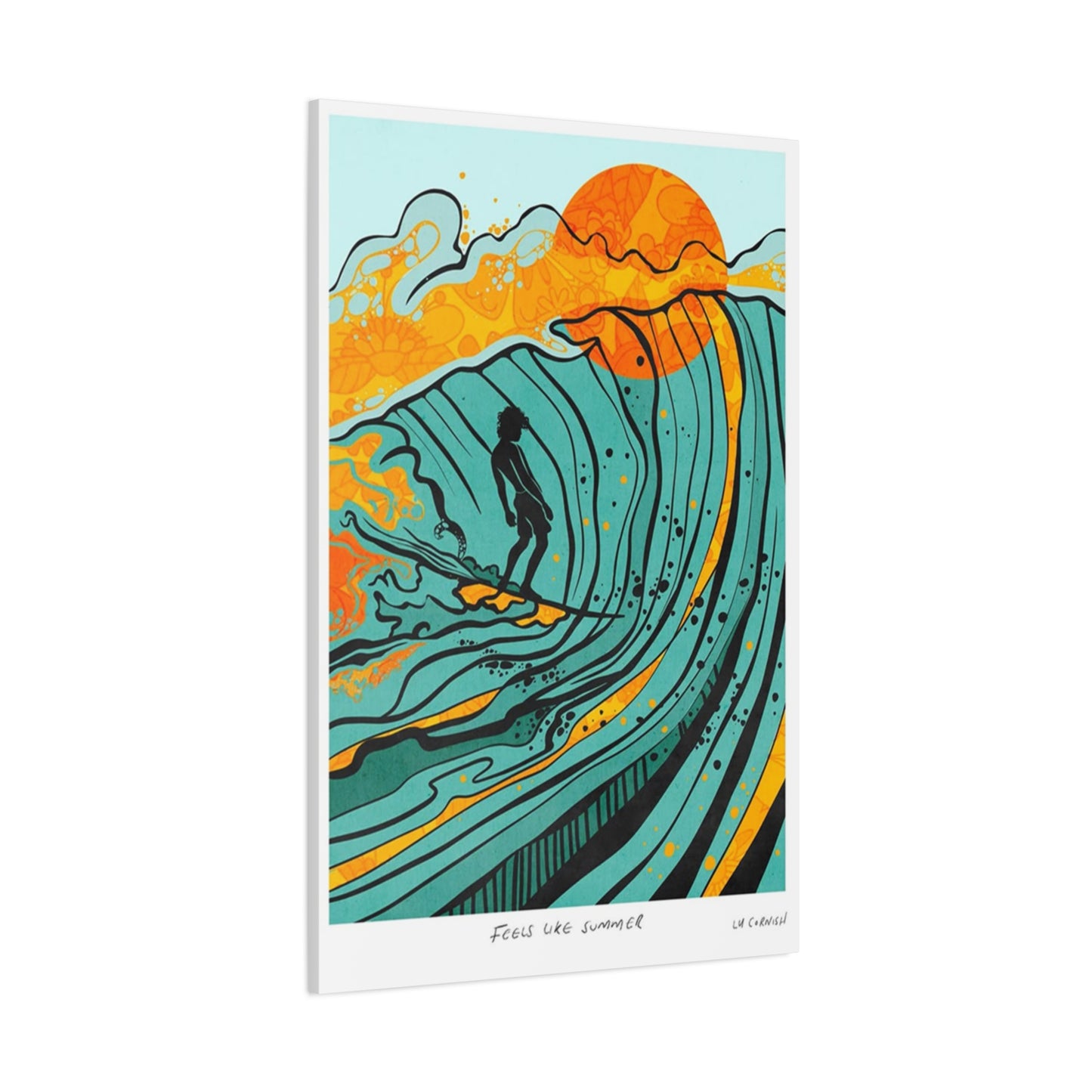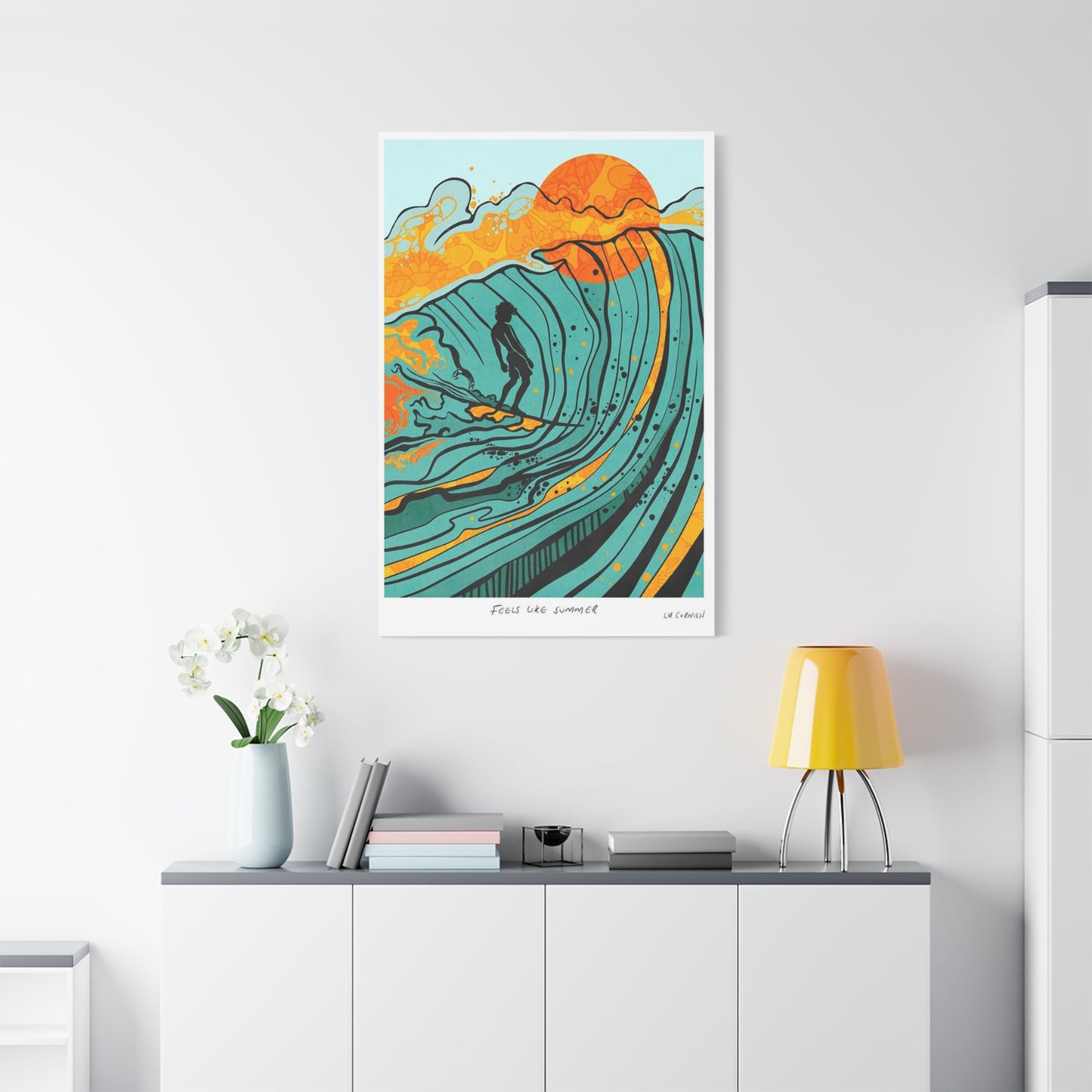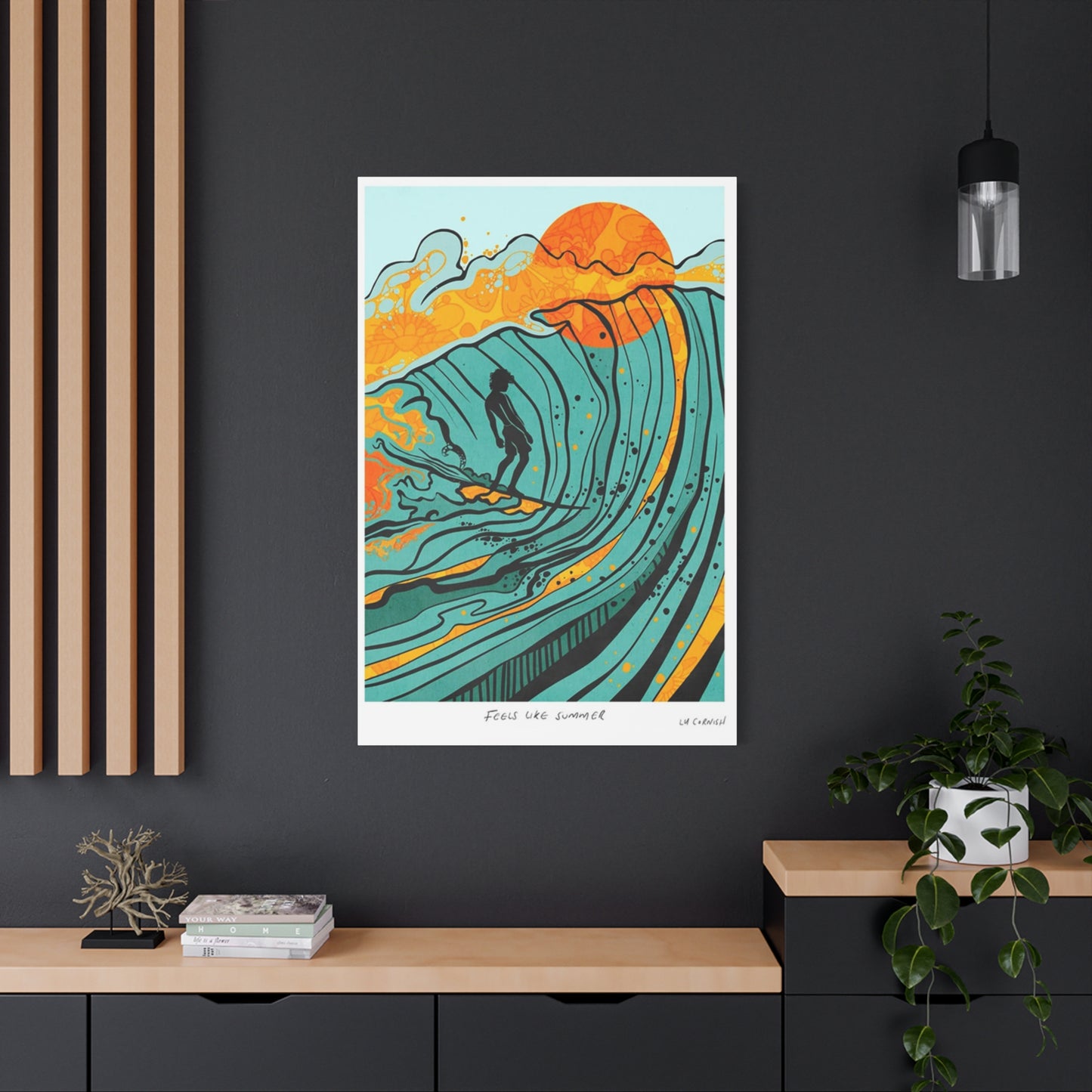Surfing and Sketching: How the Ocean's Energy Inspires Drawing Wall Art
The allure of the ocean has captivated humanity for millennia, and few activities embody the raw power and beauty of the sea quite like surfing. For those who feel an inexplicable pull toward coastal living, wave riding, and the boundless horizon where sky meets water, surfing drawings offer a unique way to bring that passion indoors. These artistic representations of one of the world's most exhilarating sports have evolved from simple sketches to sophisticated pieces that capture movement, energy, and the untamed spirit of the ocean. Whether you're a dedicated wave rider who spends every spare moment on your board, a beach enthusiast who finds peace in coastal settings, or simply someone who appreciates the aesthetic beauty of maritime themes, surfing drawings can transform any interior space into a personal sanctuary that celebrates the connection between humans and the sea.
This comprehensive exploration delves into every aspect of incorporating surfing drawings into your living environment, examining why these pieces resonate so deeply with ocean lovers, how they capture the essence of wave riding, and the myriad ways they can elevate your interior design. From understanding the artistic techniques that bring these drawings to life to discovering practical styling approaches that work in various spaces, this guide provides everything you need to create an environment that reflects your passion for the ocean and the surfing lifestyle.
The Compelling Appeal of Surfing Drawings for Ocean Enthusiasts
Beach lovers and surfing enthusiasts share a common thread that connects them to the ocean in profound ways. The rhythmic sound of waves crashing against the shore, the feeling of salt air on your skin, and the sight of surfers carving through crystalline walls of water create sensory experiences that linger long after you've left the coast. Surfing drawings serve as powerful visual reminders of these cherished moments, allowing you to maintain that connection to the sea regardless of how far inland you might live or how long it's been since your last beach visit.
The relationship between surfing art and its admirers goes beyond simple decoration. These pieces function as windows to experiences, emotions, and a lifestyle that prioritizes freedom, adventure, and harmony with natural forces. When you display surfing drawings in your home, you're not merely hanging pictures on walls but creating tangible connections to moments of pure joy, the anticipation before catching a wave, and the satisfaction of riding nature's energy across the water's surface.
For individuals who grew up near beaches or spent formative years learning to read waves and perfect their stance on a surfboard, these artistic representations carry deep personal significance. They evoke memories of early morning sessions when the water was glassy and smooth, afternoons spent waiting for the perfect set, and evenings watching the sun dip below the horizon while salt dried on weathered skin. Even those who have never stood on a surfboard find themselves drawn to the dynamic energy and aesthetic beauty that surfing drawings bring to interior spaces.
The versatility of surfing drawings makes them suitable for various personality types and design preferences. Some people gravitate toward highly detailed, realistic depictions that showcase the technical aspects of wave riding, including the precise positioning of the surfer's body, the spray of water cascading from the board, and the intricate patterns formed by breaking waves. Others prefer more abstract interpretations that use flowing lines and suggested forms to capture the essence of surfing without literal representation. Still others appreciate vintage-style illustrations that harken back to the golden age of surfing culture, complete with retro aesthetics and nostalgic color palettes.
The emotional resonance of surfing drawings extends to their ability to inspire and motivate. Many people find that having these images in their daily environment serves as encouragement to pursue adventures, embrace challenges, and maintain connections with activities that bring genuine happiness. During difficult periods or stressful times, glancing at a surfing drawing can provide a momentary mental escape, transporting the viewer to calmer, more peaceful settings where worries dissolve like foam on the tide.
Furthermore, surfing drawings often carry subtle messages about respect for nature, environmental consciousness, and the importance of preserving ocean ecosystems. The surfing community has long been at the forefront of marine conservation efforts, recognizing that healthy oceans are essential not only for their sport but for the planet's wellbeing. Displaying surfing art can serve as a personal reminder of these values and your commitment to protecting the natural world that provides so much joy and inspiration.
The social aspect of surfing culture also plays a role in the appeal of these drawings. Surfing has always been more than just a sport; it's a community, a way of life that brings together people from diverse backgrounds who share a common passion. Having surfing drawings in your space can spark conversations with visitors, create instant connections with fellow ocean lovers, and serve as expressions of identity that communicate something meaningful about who you are and what matters to you.
The Artistic Mastery Behind Wave Riding Imagery
Creating surfing drawings that truly capture the essence of wave riding requires exceptional artistic skill and deep understanding of both the sport and the ocean's behavior. Artists who specialize in this genre must possess technical abilities in rendering human anatomy, fluid dynamics, and environmental elements while also conveying the intangible qualities that make surfing so captivating. The most compelling surfing drawings succeed in freezing split-second moments of action while simultaneously conveying ongoing motion and energy.
The challenge of depicting waves on paper or canvas cannot be overstated. Waves are constantly changing, never static, composed of millions of water droplets moving in coordinated patterns that create shapes both beautiful and complex. Skilled artists study wave formation extensively, learning how swells develop in open ocean, how they transform as they approach shallow water, and how various conditions affect their shape and character. This knowledge allows them to create drawings that feel authentic to anyone familiar with ocean dynamics.
Human figures in surfing drawings present their own set of artistic challenges. The surfer's body must be positioned correctly for the maneuver being depicted, with weight distribution, limb placement, and overall posture reflecting actual technique rather than imagined poses. The best surfing artists often have firsthand experience with the sport, giving them intuitive understanding of how bodies move on boards, how balance is maintained on unstable surfaces, and how surfers read and respond to changing wave conditions.
The interplay between light and water adds another dimension of complexity to surfing drawings. Sunlight refracting through translucent wave faces creates stunning visual effects that artists must capture through skillful use of shading, highlights, and tonal variations. The spray thrown up by a carving turn catches light differently than the smooth surface of an unbroken wave face. Foam has its own textural qualities that require specific techniques to render convincingly. These details elevate surfing drawings from simple illustrations to sophisticated artworks that reward close viewing.
Line work in surfing drawings serves multiple purposes beyond simple outline definition. Dynamic, flowing lines can suggest movement and speed, guiding the viewer's eye through the composition in ways that mirror the surfer's path across the wave. Thicker, more deliberate lines might emphasize the solid presence of the surfboard or the surfer's body, creating contrast with lighter, more ephemeral lines used for water and spray. The artistic decision about line quality significantly impacts the overall feel and energy of the finished piece.
Composition plays a crucial role in effective surfing drawings. Artists must decide what moment to capture, from what perspective to show it, and how to frame the scene to maximize impact. Some compositions place the surfer large and central, making the human element dominant, while others show a tiny figure dwarfed by massive waves, emphasizing nature's power. The relationship between positive and negative space, the balance of elements within the frame, and the use of directional forces all contribute to how viewers experience and respond to the artwork.
Many surfing drawings incorporate elements beyond just the surfer and wave. Distant shorelines, palm trees swaying in tropical breezes, seabirds riding air currents, and other contextual details help establish setting and atmosphere. These additional elements ground the action in specific locations or create idealized composite scenes that represent the broader surfing experience rather than a single documented moment.
The choice between realistic and stylized approaches dramatically affects the character of surfing drawings. Photorealistic works strive for accuracy in every detail, documenting surfing with the precision of a photograph. More stylized approaches might exaggerate certain elements for emotional or aesthetic effect, use simplified forms to create iconic imagery, or incorporate decorative patterns and embellishments that prioritize visual appeal over literal accuracy. Neither approach is inherently superior; they simply serve different purposes and appeal to different sensibilities.
Color, even when used sparingly or merely suggested in primarily black and white drawings, profoundly influences mood and meaning. The deep blues and teals associated with tropical waters create different feelings than the gray-green tones of colder climates. Warm golden light suggests dawn or dusk sessions, while bright, high-contrast schemes convey midday energy. Even in monochromatic works, the relative darkness or lightness of tones establishes atmosphere and guides emotional response.
Designing Your Environment with Wave Riding Artwork
Successfully incorporating surfing drawings into your living space requires thoughtful consideration of various factors including room function, existing design elements, color schemes, and the atmosphere you wish to create. These artworks offer remarkable versatility, working beautifully in numerous settings from casual family rooms to formal living areas, from bedrooms seeking tranquil energy to home offices needing inspirational focal points.
The first step in styling with surfing drawings involves assessing your existing interior design and determining how these pieces will interact with current elements. In spaces with neutral color palettes dominated by whites, beiges, and grays, surfing drawings provide opportunities to introduce visual interest and personality without overwhelming the overall aesthetic. A striking black and white surfing drawing can complement minimalist interiors perfectly, adding character while maintaining the clean, uncluttered feel that defines this design approach.
For rooms with more colorful schemes, selecting surfing drawings that either complement or thoughtfully contrast existing hues ensures visual harmony. If your space features cool blues and greens reminiscent of ocean waters, surfing drawings with similar tones create cohesive, soothing environments. Alternatively, if you want the artwork to command attention, choosing pieces with colors that stand apart from their surroundings creates dynamic focal points that draw the eye and spark interest.
Scale represents another critical consideration when styling with surfing drawings. Large-format pieces make bold statements, serving as dominant features that anchor entire rooms and establish overall mood. These substantial works suit spacious areas with ample wall space, positioned where they can be viewed from multiple angles and distances. Medium-sized drawings offer flexibility, working individually as accent pieces or grouped with other artworks in gallery wall arrangements. Smaller surfing drawings excel in intimate spaces, clustered groupings, or as part of larger compositional arrangements.
Placement height significantly impacts how surfing drawings are experienced and appreciated. The standard guideline of hanging art so its center sits at eye level works well in most situations, ensuring comfortable viewing without strain. However, this rule can be adjusted based on where people typically view the artwork. In dining rooms where people are seated, slightly lower placement ensures guests can enjoy the art during meals. In hallways where people pass through standing, standard or slightly higher placement works better.
The relationship between surfing drawings and furniture arrangements affects both aesthetics and functionality. Artwork hung above sofas, beds, or consoles should maintain appropriate proportions, generally spanning two-thirds to three-quarters of the furniture's width to achieve visual balance. Too small, and the artwork appears lost and insignificant; too large, and it can feel overwhelming and cramped. Leaving adequate space between the furniture top and the artwork's lower edge, typically four to eight inches, prevents the composition from feeling cramped while maintaining clear visual connection between elements.
Lighting dramatically influences how surfing drawings are perceived and appreciated. Natural light from windows can beautifully illuminate these pieces during daylight hours, though direct sunlight should be avoided to prevent fading and damage. Artificial lighting options include picture lights mounted directly on frames, track lighting adjusted to highlight specific artworks, or strategically placed floor and table lamps that cast flattering illumination. The quality, color temperature, and intensity of light all affect how colors appear and details are perceived.
Creating thematic coherence through thoughtful pairing of surfing drawings with complementary decor elements strengthens overall design impact. Natural materials like driftwood, rope, and weathered wood reinforce coastal themes. Textiles in ocean-inspired colors and patterns, such as navy and white stripes or coral prints, enhance the maritime atmosphere. Decorative objects like vintage surfboards, glass fishing floats, or collections of shells and sea glass build upon the surfing drawing's theme, creating layered, interesting environments that tell cohesive visual stories.
Room function should inform both the selection and placement of surfing drawings. In bedrooms, where relaxation and rest are priorities, choosing pieces with calming energy, softer compositions, and serene color palettes supports the space's purpose. Living rooms and family rooms, as social gathering spots, can accommodate more energetic, dynamic surfing drawings that spark conversation and create lively atmospheres. Home offices benefit from inspirational surfing imagery that encourages creativity, risk-taking, and thinking beyond conventional boundaries.
Transforming Interiors with Maritime Artwork
The ocean possesses an almost magical ability to calm minds, inspire creativity, and remind us of forces larger than ourselves. For those living far from coastlines or unable to visit beaches as frequently as they'd like, bringing ocean elements into home environments through surfing art creates powerful psychological connections to the sea. This transformation goes beyond mere decoration, fundamentally altering how spaces feel and how occupants experience their daily surroundings.
Surfing art serves as a constant reminder of the ocean's presence, keeping that connection alive even when separated by hundreds or thousands of miles from the nearest beach. The visual representation of waves, water, and wave riding activities triggers memories of actual beach experiences, activating the same neural pathways and emotional responses associated with being by the sea. This phenomenon explains why people often report feeling more relaxed, creative, and positive in spaces adorned with ocean-inspired artwork.
The colors typically associated with surfing art contribute significantly to its atmospheric impact. Blues, from pale sky tones to deep navy hues, have been shown to reduce blood pressure, slow heart rate, and promote feelings of calm and security. Greens, representing the sea in certain lights or tropical vegetation in coastal settings, connect us to nature and renewal. Even the whites and creams of sea foam and sandy beaches create impressions of cleanliness, freshness, and open possibility.
Incorporating surfing drawings strategically throughout your home creates journey-like experiences as you move from room to room. An energetic action shot in the entryway welcomes you home with dynamic energy. A serene sunset surfing scene in the bedroom promotes peaceful sleep. A vintage-style surfing drawing in the kitchen adds playful character to utilitarian space. This thoughtful distribution of ocean-inspired artwork creates thematic continuity that makes the entire home feel cohesive and intentional.
The sensory associations triggered by surfing art extend beyond visual stimulation. When viewing these drawings, many people report mentally hearing the sound of waves, feeling the sensation of cool water, or even detecting the scent of salt air. These multisensory responses demonstrate how powerfully visual art can activate memory and imagination, essentially bringing ocean experiences into your home through the gateway of visual representation.
For families with children, surfing art can inspire curiosity about marine environments, encourage active outdoor pursuits, and instill appreciation for natural beauty from young ages. Kids growing up surrounded by ocean imagery often develop strong environmental consciousness and desire to protect marine ecosystems. The adventurous spirit embodied in surfing drawings can motivate young people to embrace challenges, try new activities, and pursue their passions with dedication.
Seasonal changes present opportunities to refresh how surfing drawings interact with your space. During warmer months, these pieces naturally complement open windows, light fabrics, and bright, airy color schemes. In winter, surfing art provides welcome reminders of summer warmth and serves as visual promises of adventures to come when weather improves. Some people choose to rotate their surfing drawings seasonally, displaying more vibrant, energetic pieces in summer and more contemplative, serene works during colder months.
The therapeutic benefits of connecting with nature, even through artistic representation, have been extensively documented. Hospital rooms with nature artwork promote faster healing. Office spaces with natural imagery reduce stress and increase productivity. Homes filled with ocean-inspired art create sanctuaries where residents can decompress, recharge, and maintain emotional equilibrium despite external pressures and demands.
Streamlined Wave Riding Imagery for Contemporary Coastal Aesthetics
The minimalist design movement, characterized by simplicity, clean lines, and careful editing of elements to include only what serves purpose or brings joy, has profoundly influenced contemporary interior design. Within this aesthetic framework, surfing drawings executed in minimalist styles offer perfect solutions for those seeking to celebrate ocean connections while maintaining uncluttered, serene living environments. These pared-down interpretations of surfing subjects strip away unnecessary details, focusing on essential forms and gestures that communicate meaning through elegant simplicity.
Minimalist surfing drawings typically employ limited color palettes, often working entirely in black and white or incorporating just one or two accent colors. This restraint creates sophisticated, timeless pieces that won't compete with other design elements or feel dated as trends evolve. The stark contrast between dark lines and light backgrounds creates graphic impact that commands attention despite the absence of elaborate detail or decoration.
Line quality takes on heightened importance in minimalist surfing drawings, as each mark must work harder to convey meaning when supporting details are removed. Single continuous lines might suggest an entire wave form, while a few strategic strokes capture a surfer's posture and movement. The negative space, the areas left blank, becomes as important as the drawn elements, creating balance and allowing the viewer's eye to rest. This interplay between presence and absence embodies core minimalist principles.
Subject matter in minimalist surfing art tends toward iconic, easily recognized imagery rather than complex scenes requiring extensive detail to parse. A single surfer silhouetted against a simple wave form communicates immediately and clearly without need for elaboration. These streamlined compositions work beautifully in contemporary interiors where every element is carefully curated and excessive decoration is deliberately avoided.
The philosophical alignment between surfing culture and minimalist principles runs deeper than mere aesthetic compatibility. Surfing at its essence requires only a board, waves, and the surfer's body and skill. The best surfers often speak about achieving flow states where conscious thought falls away and pure response takes over. This stripping away of unnecessary mental clutter to focus on essential experience mirrors the minimalist approach to living and design.
Minimalist surfing drawings pair exceptionally well with natural materials common in coastal and contemporary design. Light woods, whether in frames, flooring, or furniture, complement the organic subject matter while maintaining visual lightness. White or light neutral walls provide perfect backdrops that allow the artwork's simple forms to shine without competition. Natural fiber textiles in furnishings add subtle texture without introducing visual busyness that would conflict with the minimalist aesthetic.
The versatility of minimalist surfing drawings makes them suitable for virtually any room in the home. In bedrooms, their calm simplicity promotes restful atmospheres conducive to quality sleep. In living areas, they add personality and interest without overwhelming conversation or other activities. Even in bathrooms, small minimalist surfing drawings can reinforce spa-like ambiance while providing visual interest in often-overlooked spaces.
Creating gallery walls with minimalist surfing drawings requires careful attention to spacing, alignment, and composition. The same principles of negative space that apply within individual drawings extend to how multiple pieces are arranged on walls. Adequate space between frames prevents the arrangement from feeling cluttered, while careful alignment creates satisfying order and intentionality. Mixing different sized pieces in thoughtful configurations creates dynamic arrangements that maintain minimalist integrity.
Framing choices for minimalist surfing drawings should reinforce rather than contradict the artwork's essential simplicity. Thin black frames, natural wood frames, or even frameless mounting options that allow the artwork to float directly on the wall all work beautifully. Elaborate, ornate framing would create jarring contradiction between the minimal artwork and its presentation, undermining the cohesive aesthetic you're working to achieve.
The emotional impact of minimalist surfing drawings differs subtly from more detailed, realistic works. While detailed pieces invite close examination and extended viewing as you discover nuances and particulars, minimalist works offer instant visual gratification and ongoing presence that doesn't demand attention but remains constantly available to provide calm visual anchor points throughout your day.
Ideal Maritime Art for Coastal Residences
Beach houses present unique design opportunities and challenges. These spaces exist at the intersection of indoor comfort and outdoor connection, requiring design approaches that honor both aspects. Surfing wall art emerges as an ideal decorative solution for coastal homes, bridging the gap between interior spaces and the surrounding marine environment while celebrating the activities and lifestyle that draw people to beachfront living.
The authenticity of surfing art in beach house settings carries particular resonance. In urban apartments far from water, surfing drawings function as aspirational pieces, representing desired experiences and connections. In actual beach houses, these same artworks become documentary evidence of the life being lived, reflections of daily realities rather than distant dreams. This authenticity imbues the art with different energy, transforming it from escape to celebration, from wish to reality.
Coastal homes often feature architectural elements that complement and enhance surfing wall art. Large windows framing ocean views create natural connections between the depicted waves in artwork and actual waves visible beyond the glass. Open floor plans common in beach architecture allow surfing art placed in one area to be viewed from multiple locations, maximizing its impact and presence throughout the space. High ceilings accommodate larger-scale pieces that might overwhelm more confined interiors.
The relaxed, informal atmosphere typical of beach houses invites more playful, varied approaches to displaying surfing art. While formal living rooms in primary residences might call for carefully curated, matchy arrangements, beach house interiors welcome eclectic mixes of surfing drawings in various styles, sizes, and mediums. This casualness reflects the beach lifestyle itself, where rigid rules give way to comfort, enjoyment, and personal expression.
Weather considerations specific to coastal locations influence how surfing wall art should be selected, framed, and maintained. Salt air, humidity, and intense sunlight characteristic of beach environments can damage unprotected artwork over time. Proper framing with UV-protective glazing becomes particularly important in these settings. Some homeowners choose to display prints rather than original drawings in their beach houses, reserving more valuable originals for controlled inland environments while still enjoying the imagery in their coastal retreats.
The color palettes common in beach house design naturally complement surfing wall art. Whites, creams, and soft neutrals popular in coastal interiors provide perfect backdrops that allow surfing drawings to pop without color clashing. Blues, greens, and sandy tones in furnishings and accessories create cohesive environments where artwork and surrounding design elements work in harmony. Even when beach house owners choose to incorporate brighter accent colors, surfing art's inherent connection to ocean hues typically ensures successful integration.
Outdoor living spaces common to beach properties offer additional opportunities for displaying surfing art. Covered porches, screened lanais, and protected patio areas can accommodate weather-resistant prints or specially sealed pieces that bring the surfing theme into transitional spaces between full indoors and complete outdoors. These placements reinforce the beach house's connection to its surroundings while extending the living area's visual interest beyond traditional interior walls.
Multi-generational beach houses benefit particularly from surfing wall art's universal appeal. Grandparents who remember simpler times enjoy vintage-style surfing illustrations that evoke nostalgia. Parents appreciate contemporary pieces that reflect current aesthetics and their own beach experiences. Teenagers and young adults connect with action-oriented surfing drawings that capture energy and adventure. This cross-generational appeal makes surfing art smart decorating choice for vacation homes where extended families gather.
Rental beach properties gain competitive advantages through thoughtful use of surfing wall art. Vacationers seeking coastal experiences appreciate arriving to spaces that immediately communicate beach lifestyle through carefully chosen decor. Professional photographs of rental interiors featuring appealing surfing art attract potential guests browsing listings. The relatively modest investment in quality surfing prints delivers returns through increased bookings and ability to command higher rental rates.
Beach house owners often possess personal collections of surf-related memorabilia including vintage boards, competition trophies, surf wax, and photographs from memorable sessions. Surfing wall art integrates beautifully into displays incorporating these items, creating layered, personally meaningful arrangements that tell visual stories about the owner's relationship with surfing and the sea. These curated vignettes transform walls into biographical tributes to ocean-centered lives.
Establishing a Wave Rider's Haven Through Artistic Expression
For dedicated surfers, the sport transcends mere hobby to become central life focus and primary source of identity. Creating living spaces that reflect and celebrate this passion requires thoughtful curation of elements that capture surfing's essence while maintaining functional, comfortable home environments. Surfing drawings serve as foundational elements in these surfer's paradise interiors, establishing thematic direction while allowing flexibility for personal touches and evolving preferences.
The surfer's home should immediately communicate passion and priorities to anyone who enters. Surfing drawings in the entryway set the tone, announcing to visitors what matters to the residents before they've progressed beyond the threshold. These first-impression pieces might include dramatic action shots that convey excitement, iconic imagery recognizable to fellow surfers, or artistic interpretations that reveal sophisticated taste beyond stereotypical surf bum cliches.
Living areas in surfer-focused homes often center around surfing-themed gallery walls that combine drawings with photographs, vintage surf posters, and three-dimensional elements like fins, leashes, or small sculptures. These expansive displays create immersive environments that surround occupants with imagery reinforcing their passion. The careful curation required to make such extensive arrangements feel cohesive rather than chaotic demonstrates the difference between thoughtful design and mere accumulation of surf stuff.
Personal surf rooms or dedicated spaces for board storage, wetsuit drying, and surf gear organization offer perfect settings for more extensive surfing drawing collections. These functional spaces need not sacrifice aesthetic appeal, and thoughtfully placed artwork transforms utilitarian areas into galleries that celebrate the sport while serving practical purposes. Drawing inspiration from high-end surf shops, these spaces can achieve retail-quality visual appeal while remaining functional for their intended purposes.
Bedrooms in surfer homes benefit from more contemplative surfing drawings that promote relaxation rather than pump adrenaline. Peaceful lineup scenes, solo surfers silhouetted at sunset, or abstract wave patterns work better than intense action shots for spaces dedicated to rest and restoration. These calmer pieces allow surfers to maintain connection with their passion while supporting the bedroom's primary function as sleep sanctuary.
Home offices and creative workspaces gain motivational energy from strategically placed surfing drawings. During long workdays, especially for surfers who dream of being in the water while stuck at desks, these images provide mental escapes and remind workers why they're grinding through tasks. The inspirational quality of surfing imagery, representing freedom, adventure, and peak experiences, can fuel creativity and productivity in professional contexts.
Children's rooms in surfing families offer opportunities to introduce younger generation to the sport's culture and aesthetic. Age-appropriate surfing drawings featuring cartoon-style surfers, playful designs, or simplified compositions help kids develop appreciation for the sport and ocean while decorating their personal spaces. As children grow, their surfing art can evolve to reflect developing tastes and deepening understanding of surfing culture.
Garage spaces often overlooked in design conversations merit attention in dedicated surfer homes. These areas frequently house prized board collections, and transforming garages into showroom-quality displays elevates them from mere storage to celebrated exhibitions. Surfing drawings hung among board racks, combined with proper lighting and thoughtful organization systems, turn garages into impressive spaces that honor the tools of the surfing trade.
Social spaces designed for entertaining benefit from surfing drawings that spark conversation and create shared connection among guests. Large-format pieces visible from multiple seating areas become focal points around which conversations naturally flow. These artworks serve as icebreakers, inviting surf stories, debates about technique or locations, and bonding over shared passion for riding waves.
The authenticity of surfer-created living spaces differentiates them from generically beach-themed environments. True surfer homes reflect actual experience, featuring artwork that depicts real waves, captures authentic moments, and resonates with people who know the sport intimately. This specificity and genuine connection elevate the decor from superficial theme to meaningful expression of lifestyle and values.
The Dynamic Energy Surfing Art Brings to Interior Spaces
Static environments can feel lifeless and monotonous, especially when residents lead active lifestyles or possess adventurous spirits. Surfing art introduces crucial elements of energy, movement, and vitality that animate walls and enliven entire rooms. The inherent dynamism captured in quality surfing drawings creates visual excitement that engages viewers and prevents spaces from feeling stagnant or boring.
The illusion of movement achieved in well-executed surfing drawings derives from artistic techniques that direct the eye through composition while suggesting ongoing action. Diagonal lines create dynamic tension that vertical and horizontal lines cannot match. The surfer's body position, leaning into turns or crouched for speed, conveys kinetic energy even in frozen moment. Spray particles suspended in air suggest recent action while implying imminent change. These elements combine to make surfing drawings feel alive with barely contained motion.
Physiological responses to viewing dynamic imagery differ significantly from reactions to static subjects. Studies show that images depicting movement activate motor cortex regions in viewers' brains, essentially causing them to experience vicarious physical engagement with the depicted action. When you look at a surfing drawing showing a carving turn, your brain partially simulates the physical sensations and movements involved, creating subtle but real energizing effects that contribute to room atmosphere.
The psychological impact of surrounding yourself with energetic imagery influences mood, motivation, and mindset. Environments filled with dynamic art encourage more active lifestyles, creative thinking, and willingness to take calculated risks. This effect proves particularly valuable for people in creative professions, athletes maintaining training motivation, or anyone seeking to cultivate more adventurous approach to life.
Contrast between energetic surfing drawings and calmer surrounding elements creates balanced environments that feel stimulating without becoming overwhelming. A dramatic action shot gains impact when displayed against minimalist background, while multiple energetic pieces grouped together can create intensity perfect for specific spaces. Understanding how to modulate and distribute energy through art placement represents important design skill.
Different surfing scenarios captured in drawings convey varying levels and types of energy. A surfer dropping into a massive wave communicates raw power and courage. Someone executing a stylish cutback demonstrates technical skill and grace. A longboarder nose-riding conveys smooth, flowing energy rather than explosive action. Selecting drawings that match desired energy levels for specific spaces allows precise calibration of atmosphere.
The directional flow implied by surfing drawings affects how they interact with room layouts and traffic patterns. A surfer moving left to right guides eyes in that direction, potentially toward windows, doorways, or other focal points. This directional quality can reinforce architectural features or deliberately counterbalance them, depending on desired effects. Understanding and leveraging these directional forces adds sophistication to placement decisions.
Temporal qualities in surfing drawings, the specific moment chosen for depiction, significantly impact perceived energy. The anticipation before dropping in, the committed descent down the face, the explosive initiation of a turn, and the flowing completion of a maneuver each possess distinct energetic signatures. Experienced collectors learn to recognize these subtleties and select pieces that capture the precise feeling they want to introduce into their spaces.
Scale amplifies or dampens the energetic impact of surfing drawings. Large-format action shots command attention and dominate spaces with their presence, making bold statements impossible to ignore. Smaller pieces can cluster to create energetic fields that build intensity through accumulation rather than individual scale. The relationship between artwork size and viewing distance affects how fully viewers can absorb the depicted action and energy.
Living with energetic surfing art creates positive feedback loops that influence behavior and lifestyle choices. These images serve as daily reminders of what's possible, what's exciting, and what brings joy. Over time, this consistent exposure to dynamic, adventurous imagery can gradually shift perspectives, encouraging residents to embrace more active, engaged approaches to life beyond their walls.
Infusing Interiors with Adventurous Spirit Through Surfing Prints
Adventure means different things to different people, but common threads include willingness to embrace uncertainty, seek novel experiences, test personal limits, and engage fully with life's possibilities. Surfing embodies these qualities, requiring surfers to venture into dynamic, unpredictable environments where outcomes cannot be controlled or guaranteed. Surfing drawing prints bring this adventurous essence indoors, functioning as visual manifestations of courage, curiosity, and commitment to extraordinary experiences.
The symbolic power of surfing imagery extends beyond literal representation of the sport. Waves themselves symbolize change, power, opportunity, and the unstoppable forces of nature. Surfers riding these waves represent humanity's capacity to harness natural power, find harmony with overwhelming forces, and experience transcendence through skillful engagement with the environment. Displaying these images creates spaces that celebrate these deeper meanings alongside surface appreciation of aesthetic beauty.
For people who identify as adventurous but face practical constraints limiting active pursuit of extreme experiences, surfing prints offer vicarious access to adventure. The parent juggling career and family responsibilities, the retiree whose body no longer permits physically demanding activities, and the desk worker dreaming of less conventional life can all maintain connection to adventurous spirit through carefully chosen artwork that keeps that flame alive.
The aspirational quality of surfing drawing prints motivates and inspires. These images remind viewers of goals yet achieved, adventures still awaiting, and versions of themselves they aspire to become. This forward-looking, possibility-focused energy counters stagnation and complacency, keeping residents mentally engaged with growth, development, and expansion of life experiences.
Gifting surfing drawing prints to loved ones communicates understanding and support for their adventurous nature. These thoughtful presents acknowledge recipients' desires for excitement, respect their courage to pursue unconventional paths, and provide tangible reminders that someone believes in their capacity for extraordinary experiences. The enduring nature of quality prints means these gifts continue delivering emotional impact long after presentation.
Corporate environments benefit from strategic placement of adventurous imagery including surfing prints. Companies seeking to cultivate cultures of innovation, creative risk-taking, and bold thinking can reinforce these values through visual environments that celebrate adventurous spirit. Employee areas featuring surfing art subtly communicate that calculated risk-taking is valued and that the organization respects individual pursuits of passion outside work.
The narrative potential of surfing prints allows creation of visual stories across multiple pieces. A sequence might show anticipation, action, and reflection stages of the surfing experience. This storytelling approach adds depth and sophistication to collections while encouraging viewers to engage more deeply with the artwork rather than passively registering its presence.
Seasonal rotation of surfing prints maintains freshness and allows residents to emphasize different aspects of adventure throughout the year. Summer might feature high-energy action shots matching longer days and increased activity. Winter could showcase more contemplative pieces that honor the value of reflection and planning for adventures to come. This rotation prevents visual boredom while maintaining consistent thematic direction.
The accessibility of high-quality surfing prints democratizes art collection, allowing people at various economic levels to surround themselves with inspiring imagery. While original drawings command significant prices, excellent prints provide affordable entry points into collecting. This accessibility ensures that adventurous spirit and appreciation for surfing culture aren't limited to those with substantial disposable income for art acquisition.
Digital integration creates new possibilities for displaying surfing prints through electronic frames capable of rotating images, adjusting to lighting conditions, and even animating static images. These technological approaches complement traditional printing, offering flexibility and variety impossible with physical media alone. The ability to change displayed surfing scenes at will allows residents to match artwork to mood, time of day, or specific occasions.
Integrating Wave Riding Imagery with Contemporary Design Principles
Modern interior design emphasizes clean lines, functional beauty, thoughtful material selection, and spaces that enhance rather than complicate daily life. Successfully incorporating surfing drawings into these carefully composed environments requires understanding how these artistic pieces can complement rather than contradict contemporary design principles. When thoughtfully selected and properly placed, surfing art enhances modern interiors while maintaining the sophisticated aesthetic that defines this design approach.
Color coordination forms the foundation of successful integration. Modern interiors typically employ restrained palettes with deliberate color choices serving specific purposes. Surfing drawings selected for these spaces should either harmonize with existing colors or provide intentional contrast that creates focal points without disrupting overall schemes. Monochromatic surfing art works beautifully in spaces dominated by neutrals, while pieces incorporating blues and greens naturally complement modern interiors already featuring these nature-inspired hues.
Conclusion:
In conclusion, the connection between surfing and sketching highlights the powerful influence of nature on art and creativity. The ocean, with its dynamic energy, offers a profound source of inspiration for artists, particularly those who enjoy capturing the raw beauty and motion of the waves. The rhythm and flow of the water, its ever-changing patterns, and the physical interaction of surfers with the sea all provide rich imagery that can be translated into stunning works of art.
Surfing itself is an art form, blending athleticism, style, and nature’s unpredictability. For many surfers, the act of riding the waves is not just a sport but a way of expressing personal freedom and connection with the natural world. Similarly, sketching the ocean’s energy and the movement of surfers in mid-motion allows artists to express a deeper connection to this rhythm. Whether through abstract waves, realistic depictions of surfers, or stylized representations, the relationship between the surfer and the ocean becomes a compelling visual narrative.
Sketching is a way to capture that fleeting moment—the rush of a wave breaking, the grace of a surfer carving through the water, or the endless horizon where the sea meets the sky. It freezes motion and translates it into something tangible. Wall art that reflects this synthesis of surfing and sketching not only brings the beauty of the ocean into people’s homes but also serves as a reminder of nature’s powerful influence on human creativity.
In a broader sense, the combination of surfing and sketching represents an ongoing dialogue between action and reflection. Surfers engage with the ocean in a dynamic, physical way, while artists observe, interpret, and document this engagement in a more reflective, thoughtful manner. Together, these two pursuits highlight how art can evolve from nature’s raw energy, making the ocean not only a place for adventure but also a wellspring of creative inspiration.

















